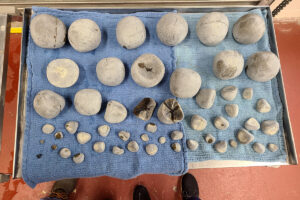Treating Severe Forelimb Pain With a Continuous Nerve Blockade (AAEP 2010)
Veterinarians can reduce a horse’s severe forelimb pain by administering a continuous, low-dose infusion of the local anesthetic bupivacaine, but this method is not suitable for every case, according to researchers from Cornell University’s College of Veterinary Medicine.
"Severe forelimb pain can occur with fractures, joint or tendon sheath infections, or traumatic injuries," explained Ashlee E. Watts, DVM, Dipl. ACVS, a graduate student pursuing a PhD and a part time large animal surgeon, who presented a study on this subject at the 2010 American Association of Equine Practitioners Convention, held Dec. 4-8 in Baltimore, Md. "In response to the reluctance to bear weight on a severely painful limb, increased weight bearing stresses are placed on the opposite forelimb, which can lead to support limb laminitis."
Veterinarians can administer epidural medications in the hind limb to drastically reduce pain. Since an epidural cannot be used for forelimb pain, Watts and colleagues assessed the use of a continuous peripheral nerve blockade (CPNB). This technique is performed by inserting a catheter in the mid-metacarpal (cannon bone) region between the suspensory ligament o the deep digital flexor tendon and continuously administering bupivacaine to the palmer nerves. These nerves are responsible for transmitting pain signals from the tissues of the distal cannon bone, fetlock, pastern and foot to the spinal cord and brain.
Watts and colleagues compared the effect of administering bupivacaine via CPNB at a rate of 0.14 mL/hour to that of injecting bupivacaine only intermittently (0.85 mL every six hours). They studied 14 horses with experimentally induced forelimb pain over three days
Create a free account with TheHorse.com to view this content.
TheHorse.com is home to thousands of free articles about horse health care. In order to access some of our exclusive free content, you must be signed into TheHorse.com.
Start your free account today!
Already have an account?
and continue reading.

Related Articles
Stay on top of the most recent Horse Health news with

















